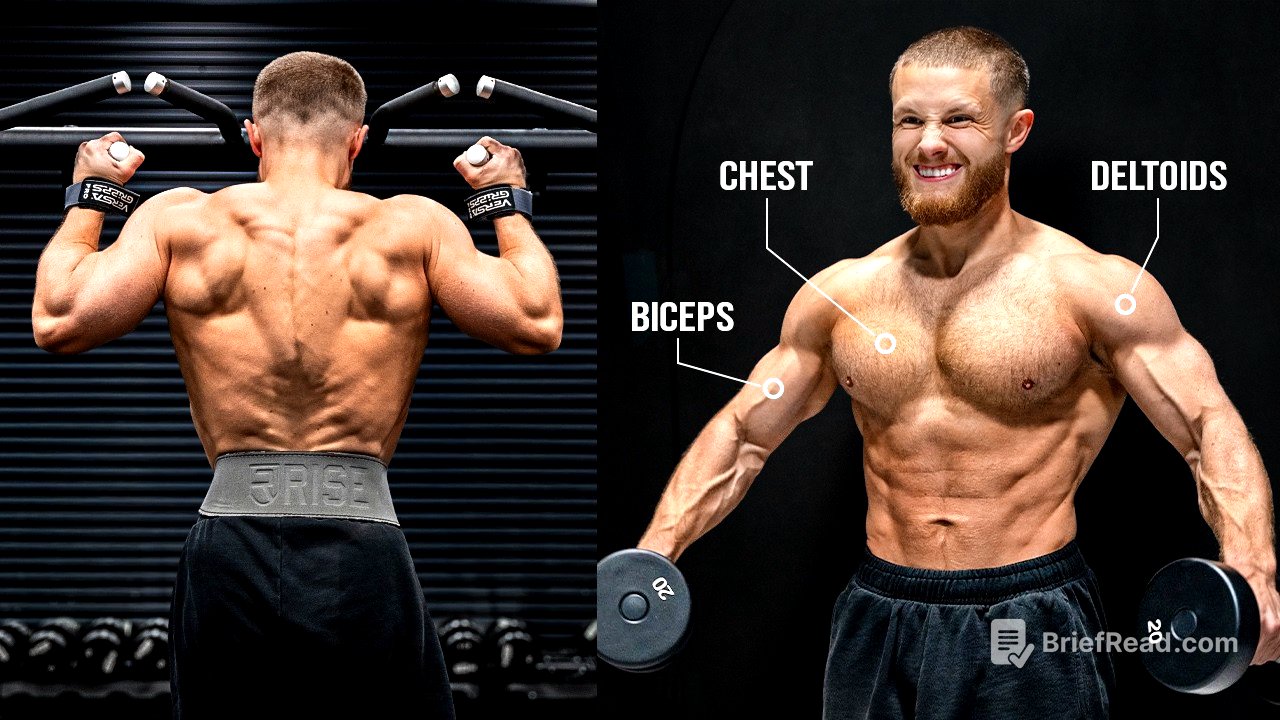TLDR;
Jeff Nippard discusses the upper body workout routine he followed for a year, which led to significant physique improvements and lean mass gain. He details seven key exercises, emphasizing technique, progressive overload, and failure sets. The exercises include incline barbell bench press, seated cable fly, weighted pull-ups, high cable lateral raises, deficit penlay row, cable overhead triceps extension, and Beijian cable curl.
- Incline barbell bench press is highlighted for chest and front deltoid growth.
- Weighted pull-ups are promoted to S tier for overall back development.
- High cable lateral raises are recommended for side deltoid isolation.
- Cable overhead triceps extension is noted as the most effective triceps movement.
- Beijian cable curls are favored for biceps growth due to muscle length and tension.
My 1 year experiment recap [0:00]
Jeff Nippard shares the results of his year-long upper body workout experiment, noting significant improvements in his back, chest, and shoulders. He gained 2.7 lbs of lean mass and increased his bicep peak, measured by DEXA and ultrasound, respectively. The video will cover the specific exercises and technique cues that contributed to these gains.
Exercise 1 (Chest, Shoulders, Triceps) [0:31]
The incline barbell bench press is identified as the most effective exercise for chest growth. It targets the chest and front deltoids, with additional activation in the triceps and side deltoids. Jeff prefers the barbell version over dumbbells due to its superior overload potential and free weights over the Smith machine for increased stabilizer muscle activation. A 45-degree incline hits the upper pecs harder while still engaging the mid and lower pecs. He focuses on a slightly narrower grip to increase range of motion and triceps engagement, always pushing the last set to absolute failure without a spotter. Bouncing the bar off the chest is discouraged to maintain consistent technique.
Exercise 2 (Chest) [2:44]
The seated cable fly isolates the pectoral muscles, offering a greater stretch than compound presses. The setup involves positioning a bench far out in front of a cable machine, easing into the seat to avoid being pulled backward, and pressing the handles forward. Focus on bringing the elbows together during the exercise to maintain tension on the chest and prevent the triceps and front deltoids from taking over. The exercise involves sweeping the weight out and back in an arc to maximize the range of motion. Seated cable flies are preferred over pec deck machines for a deeper stretch and greater stability, ensuring tension is focused on the pectoral muscles. Keeping the elbows up is crucial to maintain proper pec activation.
Exercise 3 (Back, Biceps) [4:13]
Weighted pull-ups are highlighted as a key exercise for back development and are promoted to S tier. Pull-ups engage the lats, mid traps, rhomboids, low back, biceps, and core. Jeff prefers pull-ups over lat pulldowns due to their increased difficulty and the limitation of swinging. Technique cues include focusing on getting the chest to the bar and pulling with the back rather than the arms by driving the elbows down and in. Liquid chalk and straps are used to prevent grip from limiting back gains. A grip between pronated wide and neutral is used for comfort. The focus should be on progressive overload rather than overly focusing on feeling the lats. Assisted pull-ups, band or machine, and eccentric-only pull-ups are recommended for those who cannot yet do weighted pull-ups.
Exercise 4 (Shoulders) [6:54]
High cable lateral raises are credited for improvements in side deltoid development. Two to three sets of 8-10 reps are performed with intensity. Cables provide consistent tension throughout the range of motion, unlike dumbbells. Setting the cable higher maximizes tension when the deltoids are most stretched. A recent study showed similar side delt growth with both cable and dumbbell lateral raises, but the study didn't have subjects perform cable lateral raises with full range of motion. The most common mistake is shrugging the weight up, which shifts tension to the upper traps. Focus on sweeping the weight out rather than lifting it up.
Exercise 5 (Back, Biceps) [9:16]
The deficit penlay row is presented as an exercise that activates every muscle fiber in the back. It provides mid-trap engagement, upper and lower trap activation, lat activation, and spinal erector engagement. Standing on a bumper plate increases the range of motion, providing a deeper stretch for the lats. The execution involves an explosive positive movement with a slow, controlled negative to maintain eccentric tension. Lengthened partials are used on the last set to push beyond failure. The most significant mistake is not getting fully horizontal, which reduces the activation of the mid traps and rhomboids. Straps or chalk are recommended to avoid grip limitations.
Exercise 6 (Triceps) [10:57]
The cable overhead triceps extension is identified as the most effective movement for all three heads of the triceps. Research indicates it leads to significantly more growth compared to pushdowns. The most common mistake is setting the cable too low, wasting energy during setup. The cable should be set higher, using the legs to lift the weight into position.
Exercise 7 (Biceps) [11:46]
The Beijian cable curl is compared to the preacher curl in recent studies, with non-significant trends favoring the Beijian curl. Jeff continues to favor Beijian curls due to the combination of long muscle length and high tension in the lengthened position. On pull days, preacher curls and hammer curls are also incorporated.
